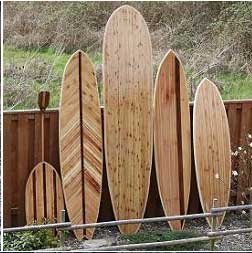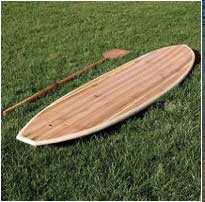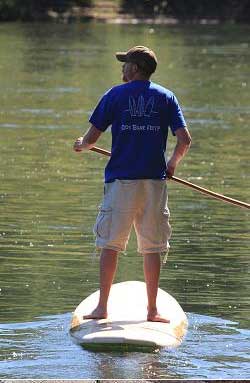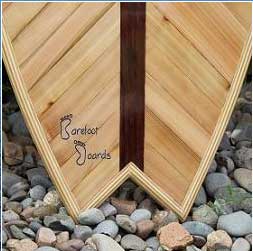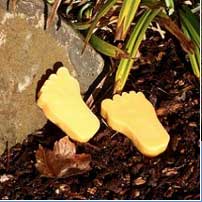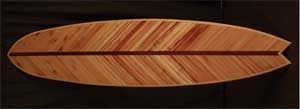
A few years ago, Chris Bryant was on vacation in Hawaii when his wife saw a wooden paddleboard and asked, “Do you think you could build one of those?”
“I said ‘sure,'” said Chris. Back in Oregon, he has now built about 30 of them. “It’s a lot of steaming, and a lot of clamping,” Chris said. For the most part, he builds the boards with traditional tools such as spokeshaves and handplanes, because “it’s more fun than electric,” he said. “Pretty much the only time I’m using machines is when I need to rip a board.”
After completing a wooden board — the steaming comes in due to the rockers on the front and back of the paddleboards — Chris wraps it in fiberglass to keep it watertight, with a vent in the board to allow for seasonal expansion and contraction of the wood.
Although Chris lives by a river that runs from his shop to his house, and “I’ll occasionally hop on a board and paddleboard home,” his own main aquatic hobby is sailing. “The people I race sailboats with keep asking me when I’m going to make wooden boats,” he said. (In fact, his next project is a wooden kayak that’s been requested.)
Prior to his paddleboard-making days, Chris had built surfboards out of foam, but didn’t enjoy working with that material. His prior work with wood had included building a headboard/footboard combination and a bar for his home, as well as working construction and finish carpentry jobs after graduating high school. These days, Chris’s “day job” is at Hewlett-Packard. “It’s time-consuming to make a board; I don’t think it’d ever be something I’d do full-time,” he said.
It takes him about a month to make one board. “It’s a labor of love more than anything. If I sell one, I make enough money to do another one,” Chris said.
Much of his material for the boards is recycled, from his contacts in the construction industry. “They’ll save cedar, or anything they think I could use,” he said. If he’s making a board for a “wall hanger,” it could be any wood, Chris said, and “I’d like to try purpleheart or mahogany, but I haven’t had any call for it yet.”
For those paddleboards that are meant to be used, though, Chris prefers woods like cedar and balsa — largely for the weight. “I have to lug them around, and wood boards are about five pounds heavier than foam,” he explained.
The main challenge with building paddleboards, he added, is constructing the board in terms of the volume that it will hold. “It’s kind of like the human body, with ribs and spines,” he said. “The rest of it is air-filled.” This means that there are occasionally special circumstances that he needs to take into account — for instance, “I built a tandem board for a guy in Hawaii who holds his wife up over his head, so that board had to hold more volume,” taking into account both boarders’ weights.
For the riders of his boards, Chris’s Barefoot Boards company also sells a board wax for grip for the feet. His product, he said, is organic, a way to combat the “petroleum that bleeds off into our oceans and rivers” from other types of board wax. Some people will buy padding for the grip, Chris said, “but people who buy wooden boards don’t like to put a pink or blue mat on. It takes away from the aesthetic of the board.”
Chris will be busy in his shop in the coming weeks: “A lot of people want a board for a Christmas present,” he said, plus, “I try to get most of my work done in the winter, so I can enjoy summer” — out on the water himself.
